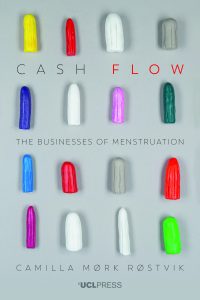In Cash Flow: The Business of Menstruation, Camilla Mørk Røstvik surveys the development of the menstrual product economy through case studies of companies in the US and Europe. Making an important contribution to research on menstrual capitalism, this book takes account of period poverty, adaptive marketing strategies and a modernising culture around menstruation, writes Ritwika Patgiri.
Cash Flow: The Business of Menstruation by Camilla Mørk Røstvik. UCL Press. 2022.
 Professor Bridget Crawford coined the term “menstrual capitalism” to describe “the marketing and selling of menstrual hygiene products by means of feminist messages that attempt to create a public-relations halo effect.” Acknowledging that not all women menstruate and not all who menstruate are women, an average woman menstruates for 38 years and disposes of 250 to 300 pounds of pads, plugs, and applicators in that time, making menstrual products a profitable industry for big corporations. The cost of these products is a significant issue for many women and girls worldwide who experience “period poverty,” a lack of access to sanitary products, sanitation services and menstrual hygiene education.
Professor Bridget Crawford coined the term “menstrual capitalism” to describe “the marketing and selling of menstrual hygiene products by means of feminist messages that attempt to create a public-relations halo effect.” Acknowledging that not all women menstruate and not all who menstruate are women, an average woman menstruates for 38 years and disposes of 250 to 300 pounds of pads, plugs, and applicators in that time, making menstrual products a profitable industry for big corporations. The cost of these products is a significant issue for many women and girls worldwide who experience “period poverty,” a lack of access to sanitary products, sanitation services and menstrual hygiene education.
The cost of [menstrual] products is a significant issue for many women and girls worldwide who experience ‘period poverty,’ a lack of access to sanitary products, sanitation services and menstrual hygiene education
However, menstrual culture is changing. There have been increased efforts to tackle the stigma around menstruation, which can impact school attendance for girls and restrict women’s ability to participate in society. There are movies, documentaries, and TV shows with menstruation plot lines. New Zealand, Scotland, and Kenya and charities in numerous other countries are tackling period poverty, distributing free products in schools, prisons and other institutions. In Assam, India, distribution of menstrual products in the aftermath of the floods is being carried out by non-governmental organisations. The booming menstrual economy has evolved in an age of social media where inclusivity and identity have become important talking points; in the UK, an online petition to abolish the VAT on menstrual products prompted legislative change.
There have been increased efforts to tackle the stigma around menstruation, which can impact school attendance for girls and restrict women’s ability to participate in society
Camilla Mørk Røstvik’s Cash Flow: The Business of Menstruation explores the development of the menstrual product economy through various case studies of companies in Europe and United States. The book further seeks to understand how brands appropriate and contribute to menstrual education and activism to better advertise their products in an evolving market (29). The author argues that Western nationalism and exceptionalism have been integral to menstrual capitalism and branding. The association of menstrual blood with impurity historically led the industry to associate menstrual products with purity, femininity, and (often) whiteness to sell products. Mørk Røstvik dismisses the recent urge to frame the menstrual product industry as “feminist capitalism,” arguing that this disguises ongoing patriarchal hierarchies, gender bias, and poor working conditions for its mostly female workers.
Mørk Røstvik dismisses the recent urge to frame the menstrual product industry as ‘feminist capitalism,’ arguing that this disguises ongoing patriarchal hierarchies, gender bias, and poor working conditions for its mostly female workers
The book presents six case studies of prominent companies in the sector which illustrate how the industry has changed over time. Chapter 1 narrates the story of menstrual product and diaper company Saba, a brand built on nationalism, biblical and moral connotations (the brand name refers to the Queen of Sheba), Scandinavian exceptionalism, gender equality and progressive politics in Norway’s post-war and pre-oil economic landscape. Established by three men, Saba was dominated by female staff but had very few female leaders (38), a structure common to all early menstrual product companies. Saba monopolised the Norwegian market from the 1940s to the 1970s, created employment opportunities for women, and provided menstrual products in remote and rural areas. That said, Saba thrived on cheap labour and poor working conditions and regulations that prevented women with children from staying in the workforce.
The second chapter explores the history of the Swedish company Essity. Established as a textile company in the 1800s and later acquired by another company, it rebranded itself as Essity in 2017. In each phase, innovative marketing remained the key focus – from the jeans pad (an innovative pad wrapped in a plastic layer resembling a jean trouser pocket) to the publication of a magazine for its media literate consumers. Like Saba, Essity evoked nationalist rhetoric when foreign brands and the menstrual cup entered the Nordic market. Essity relied on advertising and had to change strategies when the menstrual poverty debate became prevalent as activists amplified the Tampon Tax and Period Poverty in the 2010s. As a response, the company donated 200,000 packs of menstrual products to various charities (72).
More recent strategies have adapted to the emphasis on inclusivity in advertising, embracing embraced body positivity, queerness, and diversity
Chapters 3 and 4 trace the history of two Procter & Gamble companies. The first is Tambrands, a US company that attempted to take over the Soviet market in the late 1970s through a rare American, British, and Soviet joint venture that would test, collide, and combine notions of Western and Soviet exceptionalism (81). Chapter 4 examines Always, launched in 1983, which revolutionised the market by providing pads that were extremely slim and absorbent. The fifth chapter studies the novel marketing strategies of Kimberley-Clark. Producing the YouTube series Carmilla based on the nineteenth-century Gothic short story by Irish writer Sheridan Le Fanu, the series was a subtle way of advertising its Kotex pads without mentioning the brand’s name. Through discreet advertising, Kimberley-Clark repackaged the aspirational portrait of girlhood they used in the 1960s and 70s (with slim models who epitomised white beauty standards); their more recent strategies have adapted to the emphasis on inclusivity in advertising, embracing embraced body positivity, queerness, and diversity.
The last chapter continues to trace this shift in marketing strategies from nationalism and exceptionalism to feminism and inclusivity, narrating the story of two contemporary start-ups, reusable menstrual underwear company Thinx and the menstrual tracking application Clue, both headed by women. Both companies had bold marketing strategies, claimed to be committed to intersectional feminism and disrupted the traditional menstrual market by branding their products as data driven Femtech that would empower consumers. However, both Clue and Thinx fell into controversy despite positive media coverage (the former for data surveillance and the latter for workplace harassment).
Looking at the Asian and African menstrual product industries would have enabled a fuller understanding of how menstrual capitalism has emerged globally
While the book is an attempt to capture how the menstrual product industry has evolved in Europe and the US, looking at the Asian and African menstrual product industries would have enabled a fuller understanding of how menstrual capitalism has emerged globally. The changes in the Asian and African menstrual economies could have enabled a different understanding of the evolution of menstrual capitalism. The book shows how companies have adapted their marketing strategies to suit more liberal-minded consumers. They have benefitted from menstrual activists and sought to diversify their appeal by representing a more diverse picture of women than young white girls, embracing queerness and body positivity. The menstrual industry today has been shaped by both the second-wave of feminism and intersectionality and has been incorporating more realistic and frank menstrual representation, as pushed by activists. However, corporations continue to profit while women and girls suffer from stigma and poverty. One can be certain that there will be further changes to the industry, since mainstream debates around menstruation have always impacted it. This book is an important addition to the work done on menstrual capitalism and shows how the evolving culture around menstruation is actually “good for business.”
Note: This review gives the views of the author, and not the position of the LSE Review of Books blog, or of the London School of Economics and Political Science. The LSE RB blog may receive a small commission if you choose to make a purchase through the above Amazon affiliate link. This is entirely independent of the coverage of the book on LSE Review of Books.
Image Credit: Lisa_A on Shutterstock.






